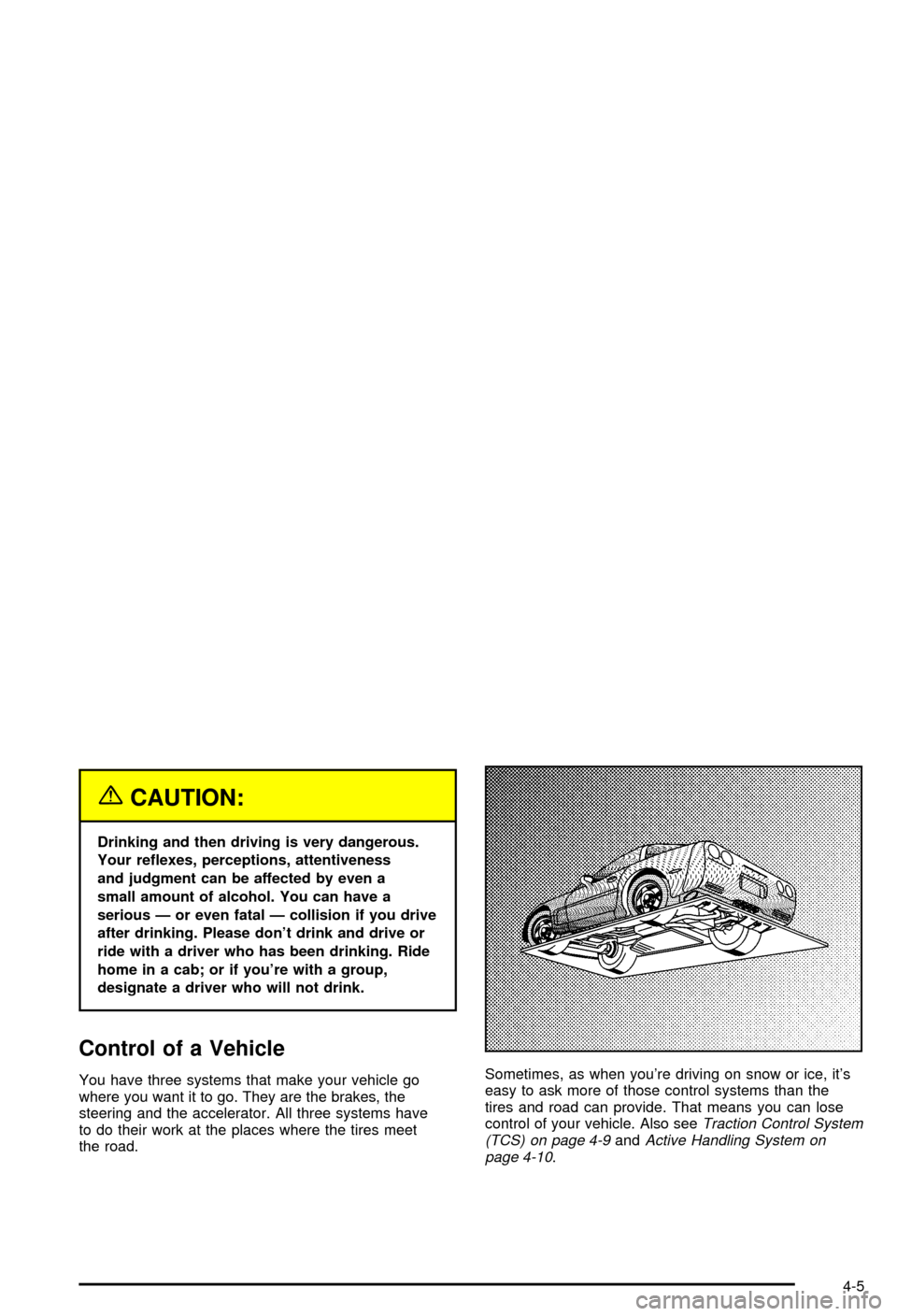2003 CHEVROLET CORVETTE active handling
[x] Cancel search: active handlingPage 197 of 368

{CAUTION:
Drinking and then driving is very dangerous.
Your re¯exes, perceptions, attentiveness
and judgment can be affected by even a
small amount of alcohol. You can have a
serious Ð or even fatal Ð collision if you drive
after drinking. Please don't drink and drive or
ride with a driver who has been drinking. Ride
home in a cab; or if you're with a group,
designate a driver who will not drink.
Control of a Vehicle
You have three systems that make your vehicle go
where you want it to go. They are the brakes, the
steering and the accelerator. All three systems have
to do their work at the places where the tires meet
the road.Sometimes, as when you're driving on snow or ice, it's
easy to ask more of those control systems than the
tires and road can provide. That means you can lose
control of your vehicle. Also see
Traction Control System
(TCS) on page 4-9andActive Handling System on
page 4-10.
4-5
Page 202 of 368

To turn the system off,
press the button located
on the console. You
can turn the system on or
off at any time by
pressing the ACTIVE
HANDLING button. The
DIC will display the
appropriate message when
you push the button.
Active Handling System
The Active Handling System is a computer controlled
system that helps the driver maintain directional control
of the vehicle in difficult driving conditions. This is
accomplished by selectively applying any one of the
vehicle's brakes.
When you ®rst start your vehicle and begin to drive away
(6 mph (10 km/h)), the message ACT HNDLG WARMING
UP may be displayed in the DIC, the instrument cluster
light will be on, and a chime will sound. This is normal.
You can acknowledge this message by pressing the
RESET button. The Active Handling System performance
is affected until the message, WARM UP COMPLETE, is
displayed in the DIC.The ACT HNDLG WARMING UP message may be
displayed in the DIC after exceeding 12 mph (20 km/h)
for 30 seconds. The Active Handling System is off
until the WARM UP COMPLETE message is displayed.
The ACTIVE HANDLING message will come on
when the system is operating. See
DIC Warnings and
Messages on page 3-53for more information. You
may also feel or hear the system working. This
is normal.
The SERVICE ACTIVE
HNDLG message will be
displayed, the instrument
cluster light will come
on, and a chime will sound
to let you know if there
is a problem with the
system. See
DIC Warnings
and Messages on
page 3-53
for more
information.
When this light and the SERVICE ACTIVE HNDLG
message are on, the system is not operational. Adjust
your driving accordingly.
4-10
Page 203 of 368

The Active Handling System comes on automatically
whenever you start your vehicle. To help maintain
directional control of the vehicle, you should always
leave the system on. You can turn the system off if you
ever need to. If you turn the Active Handling System
off, the Traction Control System will also be turned off.
Adjust your driving accordingly.
To turn the system off,
press the ACTIVE
HANDLING button on the
console. You can turn
the system on and off at
any time by pressing
the button. The DIC will
display the appropriate
message when you push
the button.Competitive Driving Mode
The driver can select this optional handling mode by
pressing the ACTIVE HANDLING button on the console
for more than ®ve seconds. Competitive Driving mode
allows the driver to have full control of the rear
wheels while the Active Handling System helps steer
the vehicle by selective brake application. The
instrument cluster light will not be on. The Traction
Control System will not be operating. Adjust your driving
accordingly.
When you press the ACTIVE HANDLING button again,
or turn the ignition to ACC, the Active Handling and
Traction Control Systems will be on. The TRAC/ACT
HNDLG-ON message will be displayed temporarily in the
DIC and a chime will be heard.
Limited-Slip Rear Axle
Your limited-slip rear axle can give you additional
traction on snow, mud, ice, sand or gravel. It works like
a standard axle most of the time, but when one of
the rear wheels has no traction and the other does, this
feature will allow the wheel with traction to move the
vehicle.
4-11
Page 221 of 368

What's the worst time for this? ªWet ice.º Very cold
snow or ice can be slick and hard to drive on. But wet
ice can be even more trouble because it may offer
the least traction of all. You can get wet ice when it's
about freezing (32ÉF; 0ÉC) and freezing rain begins
to fall. Try to avoid driving on wet ice until salt and sand
crews can get there.
Whatever the condition ± smooth ice, packed, blowing
or loose snow ± drive with caution.
Keep your traction control system on. It improves your
ability to accelerate when driving on a slippery road.
Even though your vehicle has the TCS system,
you'll want to slow down and adjust your driving to the
road conditions. The Active Handling System may
also activate. See
Traction Control System (TCS) on
page 4-9andActive Handling System on page 4-10.Your anti-lock brakes improve your vehicle's stability
when you make a hard stop on a slippery road.
Even though you have the anti-lock braking system,
you'll want to begin stopping sooner than you would on
dry pavement. See
Braking on page 4-6.
·Allow greater following distance on any
slippery road.
·Watch for slippery spots. The road might be ®ne
until you hit a spot that's covered with ice. On
an otherwise clear road, ice patches may appear in
shaded areas where the sun can't reach: around
clumps of trees, behind buildings or under bridges.
Sometimes the surface of a curve or an overpass
may remain icy when the surrounding roads
are clear. If you see a patch of ice ahead of you,
brake before you are on it. Try not to brake
while you're actually on the ice, and avoid sudden
steering maneuvers.
4-29
Page 355 of 368

A
Accessory Power Outlets.................................3-20
Accessory Power Plug.....................................5-84
Activating the Theft-Deterrent Feature................3-76
Active Handling System Light...........................3-37
Active Handling System...................................4-10
Adding Washer Fluid.......................................5-36
Additional Program Information........................... 7-9
Additives, Fuel................................................. 5-6
Add-On Electrical Equipment............................5-84
Adjusting the Speakers (Balance/Fade)......3-65, 3-69
Air Bag System..............................................1-39
Air Bag Off Switch.......................................1-44
How Does an Air Bag Restrain?....................1-42
Servicing Your Air Bag-Equipped Vehicle.........1-47
What Makes an Air Bag In¯ate?....................1-42
What Will You See After an
Air Bag In¯ates?......................................1-43
When Should an Air Bag In¯ate?...................1-42
Where Are the Air Bags?..............................1-40
Air Bag .........................................................3-33
Off Light.....................................................3-33
Readiness Light..........................................3-32
Air Cleaner/Filter, Engine.................................5-18
Air Compressor..............................................5-71
Air Dam, Front...............................................2-19
AM ...............................................................3-77
Antenna, Fixed Mast.......................................3-79
Antenna, Power Antenna Mast Care..................3-79Antennas, Integrated Windshield and Rear
Window......................................................3-80
Anti-lock Brake System (ABS)............................ 4-7
Anti-Lock Brake, System Warning Light..............3-36
Appearance Care............................................5-75
Care of Safety Belts....................................5-77
Chemical Paint Spotting...............................5-81
Cleaning the Inside of Your Vehicle................5-75
Cleaning the Outside of Your Vehicle..............5-78
Fiberglass Springs.......................................5-81
Finish Damage............................................5-81
Titanium Exhaust System..............................5-81
Underbody Maintenance...............................5-81
Vehicle Care/Appearance Materials................5-82
Weatherstrips..............................................5-77
Arming the System.........................................2-16
Ashtrays........................................................3-21
Audio System(s).............................................3-62
Care of Your Cassette Tape Player................3-78
Care of Your CD Player...............................3-79
Care of Your CDs........................................3-79
Fixed Mast Antenna.....................................3-79
Integrated Windshield and Rear Window
Antennas................................................3-80
Power Antenna Mast Care............................3-79
Radio with Cassette.....................................3-63
Radio with CD............................................3-67
Setting the Time..........................................3-62
Theft-Deterrent Feature................................3-75
Trunk-Mounted CD Changer..........................3-71
1
Page 362 of 368

LATCH System (cont.)
Latches, Seatback............................................ 1-5
Leaving Your Vehicle With the Engine Running
(Automatic Transmission)..............................2-32
Leaving Your Vehicle.......................................2-10
Lifting From the Front......................................5-66
Lifting From the Rear......................................5-67
Lifting Your Corvette, Tires...............................5-64
Lighted Visor Vanity Mirrors..............................2-15
Light.............................................................3-37
Active Handling System................................3-37
Air Bag Off .................................................3-33
Air Bag Readiness.......................................3-32
Anti-Lock Brake System Warning...................3-36
Brake System Warning.................................3-35
Check Gages Warning.................................3-42
Malfunction Indicator....................................3-38
Safety Belt Reminder...................................3-31
Security.....................................................3-42
TCS Warning Light......................................3-36
Traction Control System (TCS) Warning..........3-36
Limited-Slip Rear Axle.....................................4-11
Loading Your Vehicle.......................................4-33
Lockout Protection..........................................2-10
Locks............................................................. 2-9
Door........................................................... 2-9
Leaving Your Vehicle....................................2-10
Lockout Protection.......................................2-10
Power Door................................................2-10Loss of Control...............................................4-17
Lowering the Convertible Top............................2-50
M
Magnesium Wheel Finish.................................5-81
Magnetic Speed Variable Assist Steering............4-13
Maintenance, Normal Replacement Parts............5-94
Maintenance Schedule...................................... 6-8
At Each Fuel Fill........................................... 6-8
At Least Once a Month.................................. 6-8
At Least Once a Year.................................... 6-9
At Least Twice a Year................................... 6-9
Brake System Inspection..............................6-13
Engine Cooling System Inspection.................6-13
Exhaust System Inspection...........................6-12
Fuel System Inspection................................6-13
How This Section is Organized....................... 6-3
Introduction.................................................. 6-2
Maintenance Requirements............................. 6-2
Part A - Scheduled Maintenance Services......... 6-4
Part B - Owner Checks and Services............... 6-8
Part C - Periodic MaintenanceInspections......6-12
Part D - Recommended Fluids and
Lubricants...............................................6-14
Part E - Maintenance Record........................6-16
Rear Axle Service........................................6-13
Scheduled Maintenance................................. 6-4
Steering and Suspension Inspection...............6-12
8
Page 367 of 368

Tires.............................................................5-54
Buying New Tires........................................5-59
Chains.......................................................5-64
Extended Mobility........................................5-54
If a Tire Goes Flat.......................................5-68
In¯ation -- Tire Pressure...............................5-56
Lifting Your Corvette....................................5-64
Pressure Monitor System..............................5-57
Rotation.....................................................5-58
Tire and Wheel Inspection............................6-12
Tire In¯ator Kit............................................5-70
Uniform Tire Quality Grading.........................5-60
Wheel Alignment and Tire Balance.................5-61
Wheel Replacement.....................................5-61
To Use The Engine Coolant Heater...................2-23
Top Strap Anchor Location...............................1-31
Top Strap......................................................1-30
Torque Lock (Automatic Transmission)...............2-33
Towing..........................................................4-33
Recreational Vehicle.....................................4-33
Towing a Trailer..........................................4-35
Your Vehicle...............................................4-33
Traction.........................................................4-10
Active Handling System................................4-10
Control System (TCS).................................... 4-9
Control System Warning Light.......................3-36
Limited-Slip Rear Axle..................................4-11
Selective Ride Control..................................4-12
Transmission Operation, Automatic....................2-24
Transmission Operation, Manual........................2-27Transmission..................................................5-20
Fluid, Automatic...........................................5-20
Fluid, Manual..............................................5-20
Transportation Options...................................... 7-8
Trunk/Hatch...................................................2-11
Trunk-Mounted CD Changer.............................3-71
Turn and Lane-Change Signals.......................... 3-6
Turn Signal/Multifunction Lever........................... 3-6
Twilight Sentinel
ž(Optional in United States,
Standard in Canada)....................................3-14
U
Underbody Flushing Service.............................6-11
Understanding Radio Reception........................3-77
Uniform Tire Quality Grading............................5-60
United States ± Customer Assistance.................. 7-4
Unlocking the Theft-Deterrent Feature After a
Power Loss................................................3-76
V
Vehicle Identi®cation........................................5-83
Number (VIN).............................................5-83
Service Parts Identi®cation Label...................5-83
Vehicle Personalization....................................2-55
Memory.....................................................2-55
Vehicle Storage..............................................5-40
13